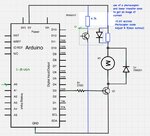Follow along with the video below to see how to install our site as a web app on your home screen.
Note: This feature may not be available in some browsers.
the current is limited by what the motor can draw.
but if you really require , you can measure or monitor in a scope.
the transistor simply operate as switch.
other than that , is it working in your test?
but it could damage the motor no?
